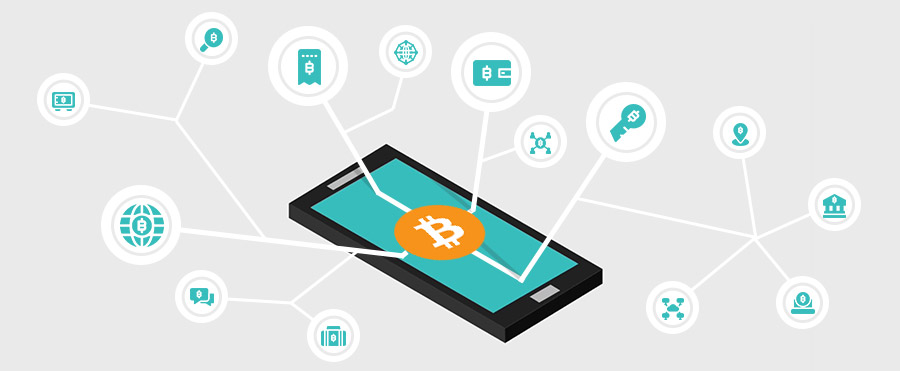Since the first public blockchain appeared to allow bitcoin transactions, blockchain technology has been making great strides towards the optimization of business processes across a wide spectrum of industries.
With all the hype surrounding the technology, the matter of how to use blockchain in mobile apps still draws some special attention.
We receive a lot of questions from our partners, eager to leverage the potential of this technology. The most frequent question is:
How will blockchain influence our mobile strategy and mobile app development in particular?
In this blog post, we’ll look at some of the advantages and shortcomings of applying blockchain technology in the mobile space.
What’s Special About Blockchain?
To recap, blockchain is a distributed digital ledger where data automatically replicates among independent nodes. All nodes equally take part in a so-called consensus — verification process that takes place on each node individually before a new block of data is added to the chain.
“The blockchain is an incorruptible digital ledger of economic transactions that can be programmed to record not just financial transactions but virtually everything of value.”
— Don & Alex Tapscott, authors Blockchain Revolution (2016)
It’s this lack of central authority that makes blockchain so lucrative: in situations when there is no trust between parties, a blockchain becomes the ideal solution for storing an uncompromised secure log of all transactions that are transparent and verifiable by all participants.

Source: Forrester Research
The Application of Blockchain in Mobile App Development
Blockchain technology has been steadily impacting the mobile app development segment. Many industries widely adopt it to ensure a reliable environment, enable safe access to data, and provide transparent and secure payment transactions.
Blockchain mobile apps have already transformed the landscape of such industries as Finance and Banking, Insurance, Healthcare, Supply Chain Management, and IoT.
For example, it’s common for insurance and financial sectors to use multiple signatures on various contracts or docs. In this case, blockchain-based apps enable turning to a mission-critical database in a reliable way. On top of that, they ensure secure access to multiple users.
Pros and Cons of Blockchain in Mobile
A recent blockchain survey by Deloitte fielded across seven countries has revealed that half of the respondents (1000+ companies) plan to invest between one and ten million dollars in blockchain solutions next year.
Let’s take a look at the advantages of this eruptive technology that companies investing in blockchain are staking on.
Distributed
As we’ve already covered, a blockchain is a distributed ledger. What this means is that for its operation a blockchain relies on multiple independent nodes and does not need a trusted authority or central server. Transactions are controlled by nodes, with no middlemen required.
As the outcome businesses gain:
- Higher profit margin
- Lower operational costs
- Quicker transactions
Will it stand the test though, if we look at the distributed nature of blockchain thru the prism of mobile? A 100% blockchain-based mobile app would effectively turn a smartphone or a tablet into a node, with quite obvious downside effects.
Blockchain vs. Mobile Storage
Mobile devices have natural constraints on how much data they can store. A blockchain mobile app can quickly eat up all free space on a smartphone or tablet.
The bigger the chain, the more room it will require on a mobile device: as of March 2021 the size of the Bitcoin blockchain has gone over 330 gigabytes. You do the math.
Blockchain vs. Mobile Performance
While it’s true that modern smartphones can compare to mid-range PCs that constitute the majority of nodes on a typical blockchain, we have to admit that the bulk of mobile devices on the market do not have enough power to support the adequate functioning of a blockchain.
On top of that, battery capacity would introduce another bottleneck, as constant connectivity and processing operations would eat up a smartphone’s energy in no time.
Secure & Immutable
Each block of data that gets onto a blockchain is verified by all nodes participating in the blockchain. A timestamp and encryption of each new piece of data make the blockchain database immune to hacks.
Surely, data immutability could find its use in mobile solutions, but prolonged verification would render the whole shenanigans pointless. Besides, many models of smartphones offer biometric authentication nowadays — already a self-sufficient security measure.
Transparent
While providing each party involved in a system with real-time access to their information, blockchain leaves no chances for any single entity to interfere with the data in a certain node without going noticed.
It means that any data manipulation is visible to any participant of the network. Without exposing personal data, blockchain technology makes it possible to see what information was altered, by whom and when. As a result, it’s out of the question to falsify data or transactions.
When an app requires increased transparency and enhanced control over data, blockchain appears to be the appropriate technology to apply.
Efficient & Rapid
Many financial institutions design and implement mobile apps to facilitate their business operations and enhance the customer experience. When it comes to transactions, a traditional approach to handle them incorporates multiple steps and verifications.
With blockchain, you don’t need any mediator to take part and complete a transaction as it allows you to streamline and automate the process. This technology empowers mobile apps to support fast and efficient operations 24/7.
So… No Blockchain in Mobile?
Not quite. Blockchain can still find its way into the mobile world. Just look at all the mobile wallet apps out there. A digital wallet app is an ideal solution for managing cryptocurrency transactions.
We just need to realize that a mobile wallet is not a blockchain-based mobile app. In fact, such a wallet only integrates with a blockchain, that in turn runs off of desktop PCs, as one would expect.
You’d be surprised to learn that most apps work this way. It’s the server that churns numbers and algorithms. In most cases, mobile apps only fetch data from a server and let you interact with this data.

Uber is an excellent case to exemplify: it’s not an app that calculates the cost of a ride, but the server; and it’s not the app that calculates the optimal route — Apple and Google have huge back-end infrastructure behind their mapping services that feed this data to Uber app.
The point we are trying to make here is that blockchain technology does not change the mobile app development principles in a meaningful way, other than offering another point of integration. An app can integrate with a blockchain and serve as a mobile interface into the blockchain.
The difference with a desktop node is that a smartphone or a tablet equipped with a blockchain-integrated app does not contribute to the operation of the blockchain: it does not store or verify blockchain data. Instead, an app can display the data via an API integration.
Future of Blockchain-Integrated Mobile Apps
Even though at present there is no clear case in favor of developing a mobile-first blockchain system, these solutions may add value to blockchain-powered systems by offering the convenience of a mobile interface.
Some of the most interesting use cases for integrating mobile apps with blockchain-based solutions include:
- Wallet apps for managing cryptocurrency transactions
- Digital identity for services such as new bank accounts, driver’s license, or utilities
- Documenting land titles and land rights
- Mobile gambling
- Cryptocurrency trading apps, etc.
Do you plan to develop a blockchain distributed app accompanied by a mobile client or want to assess the potential benefits of integrating a mobile app with a blockchain? Let us know and we will run an audit to help you identify the bottlenecks and opportunities for realizing a project on the edge of mobile and blockchain.









